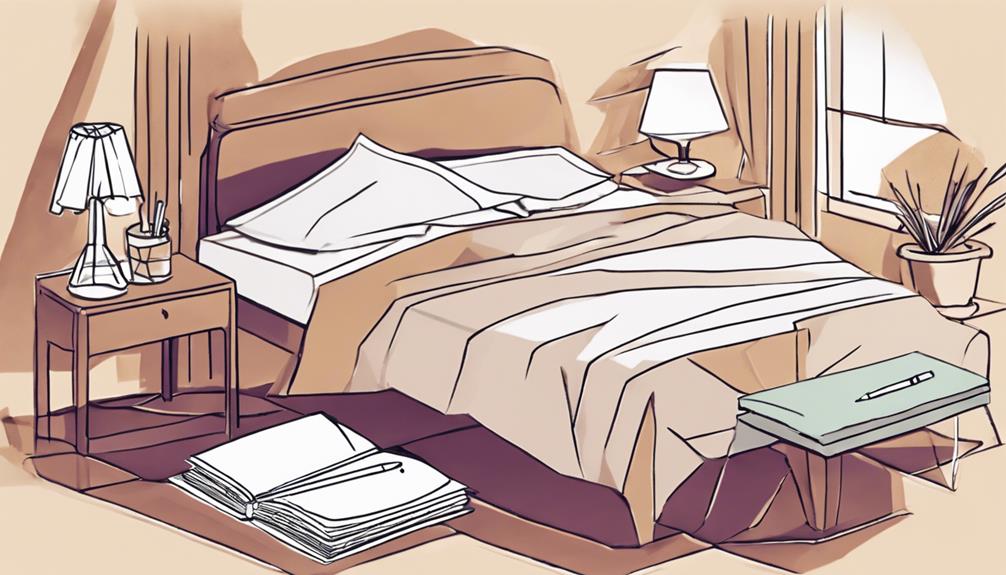To improve your sleep and ability to manifest, Abraham’s nightly routine focuses on creating a calm atmosphere. Practicing gratitude can increase positivity and alignment with the Vortex, enhancing your manifestation abilities. Visualization exercises can help clarify your desires and improve the efficiency of your manifestation efforts. Releasing negativity before bed is key to achieving a peaceful night’s sleep and successful manifestations. Affirmations and creating a tranquil environment can promote relaxation, while breathing exercises can help you feel more calm. By incorporating manifestation rituals, you can attract your desired outcomes more quickly. Discover more about Abraham’s effective techniques for better sleep and faster manifestations.
Key Takeaways
- Practice gratitude and positive visualization before bed.
- Release resistance and negative thoughts for alignment.
- Create a sacred bedtime space for manifestation energy.
- Use bedtime affirmations to prepare mind for rest.
- Incorporate breathing exercises for relaxation and manifestation.
Setting the Evening Tone
Prepare your mind and environment for a peaceful night's rest by setting a positive and grateful tone in the evening. Ending your day with appreciation and positive thoughts can have a considerable impact on the quality of your sleep.
According to Abraham's teachings, aligning yourself with the Vortex before drifting off enhances your manifestation abilities while you rest. By cultivating a sense of gratitude before bed, you raise your personal vibration levels, attracting positive outcomes into your life.
Connecting with the Vortex before sleep allows for deeper relaxation, paving the way for a more peaceful mindset throughout the night. Remember, the bedtime process not only affects your immediate sleep but also influences the energy you wake up with, which can affect your ability to manifest throughout the day.
Gratitude Practice

Starting a gratitude practice before bed can have profound effects on your overall well-being. By acknowledging the good in your life, you shift your focus towards positivity and abundance, setting the stage for a more peaceful mind and restful sleep.
Consider incorporating a gratitude journal into your nightly routine to reap the benefits of this simple yet powerful practice.
Gratitude Journal Benefits
Reflecting on the benefits of keeping a gratitude journal before bed enhances positivity and promotes better sleep quality. Expressing gratitude in a journal before sleeping helps shift your focus to the positive aspects of your life.
By taking the time to reflect on things you're grateful for before bedtime, you can reduce your stress and anxiety levels. Regularly engaging in gratitude journaling before sleep can lead to improvements in your overall well-being and increase your feelings of contentment.
The act of writing down things you're thankful for before bed can contribute to a more restful and peaceful night's sleep, setting the stage for a more positive mindset the next day. This simple practice of gratitude journaling before bedtime has been shown to have profound effects on your mental and emotional state, ultimately contributing to a better quality of sleep and overall well-being.
Daily Gratitude Reflection
Cultivating a habit of daily gratitude reflection before bed positively impacts your mindset and overall well-being. Reflecting on things you're grateful for can elevate your vibration, leading to a more peaceful and restful sleep. This practice of gratitude before sleep not only enhances your quality of rest but also has the potential to expedite the manifestation of your desires.
By focusing on the things you appreciate before bedtime, you strengthen your connection with what Abraham Hicks refers to as the Vortex, aligning your energy with the Universe and attracting more positive experiences into your life.
Ending your day with a gratitude reflection sets a positive tone for your subconscious mind while you sleep. This positive mindset can have a ripple effect on your waking hours, allowing you to approach each day with a sense of appreciation and abundance. Embracing daily gratitude as part of your bedtime routine can significantly impact your overall well-being and outlook on life.
Aligning With the Vortex

To enhance your manifestation power at bedtime, aligning with the Vortex is crucial for setting the stage for positive manifestations during the night. Being in the Vortex state while drifting off to sleep can greatly impact the outcomes of your manifestations.
By focusing on positive thoughts and feelings of appreciation before bedtime, you can maintain alignment with the Vortex, creating a conducive environment for your desires to materialize. Surrendering to the Vortex's guidance before sleep not only promotes relaxation but also allows for smoother manifestation processes to unfold effortlessly.
Practicing gratitude and appreciation at bedtime serves as a powerful tool in reinforcing your connection with the Vortex, facilitating faster manifestations. It's essential to cultivate a mindset of positivity and receptivity before sleep to harness the full potential of the Vortex's energy.
Positive Visualization Techniques

Enhance your bedtime manifestation routine by incorporating positive visualization techniques to amplify the effectiveness of the Law of Attraction. Visualizing positive scenarios before sleep can markedly enhance the manifestation process by aligning your thoughts and emotions with your desires.
Here are three key ways positive visualization techniques can benefit your bedtime routine:
- Enhanced Subconscious Priming: Engaging in positive visualization before sleep primes your subconscious mind for a restful and productive state, allowing your intentions to sink deeply into your psyche.
- Accelerated Manifestation: Focusing on desired outcomes while falling asleep can accelerate the manifestation process, bringing your goals closer to reality at a faster pace.
- Deepened Connection with the Vortex: By incorporating gratitude and appreciation into your bedtime visualizations, you deepen your connection with the Vortex, allowing for a more profound alignment with your manifestations.
Letting Go Before Bed

Letting go before bed allows for the seamless flow of manifestations while you sleep. Releasing any resistance or negative thoughts before bedtime is essential in creating a conducive environment for your desires to manifest effortlessly.
By clearing your mind and surrendering control to the Universe, you open up the pathway for the Law of Attraction to work its magic overnight. This practice sets the stage for a restful night's sleep and waking up in alignment with your intentions.
Abraham teaches that by releasing any tension or doubt before sleep, you pave the way for a more receptive state, enhancing the manifestation process. Remember, the key is to relax, let go of any worries, and trust that the Universe is orchestrating everything in your favor.
Journaling for Clarity

Journaling before bed can greatly enhance your mental clarity and emotional well-being as you prepare for sleep. By taking a few minutes to jot down your thoughts and feelings, you can reap numerous benefits that contribute to a more restful night.
Here's how journaling can help you achieve clarity before bedtime:
- Clarifying Thoughts and Emotions: Writing down your innermost thoughts can help declutter your mind, making it easier to relax and unwind before sleep.
- Alleviating Anxiety: Documenting worries or concerns can prevent them from swirling in your mind, reducing anxiety levels and promoting a sense of calm.
- Enhancing Gratitude and Contentment: Reflecting on positive experiences and expressing gratitude in your journal can foster feelings of contentment and fulfillment, setting a positive tone for bedtime.
Incorporating journaling into your bedtime routine can lead to personal insights, emotional release, and improved mental well-being, paving the way for a peaceful night's rest.
Affirmations for Sleep

Using positive affirmations before sleep can assist in calming your mind and promoting relaxation for a restful night. These affirmations play an essential role in shifting your focus from daily worries to feelings of gratitude, ultimately enhancing the quality of your sleep.
By repetitively affirming positive statements such as 'I am safe and at peace' or 'I trust in the flow of life,' you can soothe your mind and cultivate a peaceful state conducive to falling asleep. Additionally, the power of affirmations extends beyond the night; consistently using them can rewire your brain for more positive thinking patterns during sleep and carry over into the next day, fostering a mindset that accelerates the manifestation of your desires.
Embracing affirmations as part of your bedtime routine can create a harmonious environment for your mind to rest, rejuvenate, and prepare for the opportunities that await in the morning.
Creating a Sacred Space

When creating a sacred space for bedtime, remember that the design of the space matters.
Energize your environment with intention by incorporating calming elements and personal touches.
Space Design Matters
Creating a sacred space for your bedtime process involves ensuring it's clutter-free and calming to promote relaxation. To design a space that fosters peace and tranquility, consider the following:
- Soft Lighting: Incorporating gentle lighting can create a soothing ambiance conducive to winding down before sleep.
- Soothing Colors: Choose calming colors like blues, greens, or neutrals to promote a sense of serenity and relaxation in your sacred space.
- Comfortable Bedding: Investing in comfortable bedding can enhance your physical comfort and contribute to a restful night's sleep.
Energize With Intention
Designating a specific area in your bedroom as a sacred space for bedtime intentions helps energize your mind and spirit for restful sleep. By creating this dedicated space, you invite positive energy and focus into your nightly routine.
Fill your sacred space with items that resonate with you and align with your desires. Consider incorporating calming elements like candles, crystals, or essential oils to cultivate a tranquil atmosphere conducive to relaxation.
Before entering your sacred space, take a moment to set clear intentions for both restful sleep and manifestation. This practice can help center your thoughts and prepare your mind for a peaceful night's rest.
Regularly visiting your sacred space reinforces your intentions and allows you to connect with your inner self before bedtime. By energizing your space with intention, you can enhance the quality of your sleep and optimize your ability to manifest your aspirations.
Breathing Exercises for Relaxation

Engage in deep, slow breathing exercises to effectively relax your mind and body before bedtime. Deep, controlled breathing plays an important role in calming the nervous system and promoting relaxation.
Here are three key benefits of incorporating breathing exercises into your bedtime routine:
- Stress Reduction: Breathing exercises like diaphragmatic breathing have been shown to lower stress levels, helping you unwind and prepare for a restful night's sleep.
- Improved Sleep Quality: Inhaling deeply through the nose and exhaling slowly through the mouth can aid in releasing tension and promoting a sense of calm, setting the stage for better sleep quality.
- Mindfulness and Focus: By focusing on your breath, you can shift your attention away from racing thoughts and distractions, allowing your mind to ease into a state of tranquility conducive to sleep.
Consistent practice of these bedtime breathing exercises can't only enhance your overall well-being but also contribute to manifesting your desires more quickly.
Manifestation Rituals

Abraham's bedtime process incorporates manifestation rituals that focus on aligning with positive energy for faster manifestations. By engaging in these rituals before sleep, you can enhance your connection to the Vortex energy, allowing your desires to manifest more swiftly.
Reflecting on past manifestations already received can amplify the power of your future manifestations, creating a cycle of abundance. Setting intentions for the next day while in a positive state before sleep primes your mind to attract the outcomes you desire.
Practicing gratitude and appreciation as part of your bedtime routine not only fosters a sense of well-being but also elevates your personal vibration, making you more receptive to positive experiences. These manifestation rituals serve as a powerful tool to align yourself with the energy of the Universe, increasing the speed at which your dreams and desires materialize.
Embrace these practices to enhance your manifestation abilities and manifest your desires more efficiently.
Frequently Asked Questions
What to Do Before Bed to Manifest?
Focus on gratitude, visualize desires as reality, set intentions for tomorrow. Relax with deep breathing or meditation. Trust the Universe, release worries. Align with the Vortex for faster manifestations by raising your vibration and maintaining positivity.
Can You Manifest While You Sleep?
As you sleep peacefully, your subconscious mind eagerly absorbs your desires. Trust in the process. Align your thoughts with positivity and visualize your dreams. The Universe lovingly weaves your manifestations into reality effortlessly while you rest.
Will Abraham’s Bedtime Process help with Sleep Improvement as well as Mouth Taping?
Looking to improve your sleep? Why not try mouth tape for sleep as part of Abraham’s bedtime process. By incorporating both techniques, you may experience even better results for a more restful and rejuvenating night’s sleep. Give it a try and see the difference it can make for your sleep improvement.
Conclusion
To sum up, incorporating Abraham's bedtime process into your nightly routine can enhance your sleep quality and accelerate manifestation. By setting a positive tone, practicing gratitude, visualizing success, and letting go before bed, you can create a sacred space for relaxation and manifestation.
Remember to utilize affirmations, breathing exercises, and manifestation rituals to further enhance your bedtime routine.
Sweet dreams and happy manifesting!










